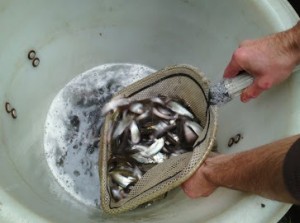-
- Buy a UK rod licence: EA Link
- 0800 807060 EA Hotline, Pollution, Poaching
- Thames Region River Levels
- Thames River Conditions
- Thames Temps and Clarity
- Thames Fishing Byelaws
- Thames Annual Tidefest
- Thames Record List
- Thames Eel Monitoring
- EA Annual Fisheries Report
- EA Flood Warnings
- Thames Sewage Discharge Notifications
- Thames Sewage Events
- Thames Tideway Tunnel
- River Thames Scheme: Reducing flood risk from Datchet to Teddington
- Martin Salter: Fighting for Fishing Blog
- Duncan Charmans World of Angling Blog
- Angling Trust
- Water and sewerage companies in England: environmental performance report 2013 – 2016
- EA Pollution incidents: 2014 evidence summary
- EA Pollution incidents: 2015 evidence summary
- River Crane and DNR Fisheries Impact assessment
- Links
Recent Tweets
Error retrieving tweetsNews Archive
Renewed calls for commercial ban of eel and elver fishing
Angling’s representative body agreed to support a ban on the taking of eels by rod and line three years ago, asking at the same time for a complete ban on the commercial exploitation of the stock. Eels have a lifecycle of between 10 and 40 years and very little is known about the factors affecting their numbers so it is just not possible to know whether a commercial harvest is sustainable.
Eels are a vital part of the aquatic ecosystem and a favourite food of cormorants and otters. It is thought that the decline in eels may have contributed to increased predation on other fish species. Eels are highly valuable and it is thought that far more eels and elvers are taken than the licences allow. The continued licensed commercial fishing of eels and elvers makes enforcement more difficult; if it were banned entirely then anglers would be able much more easily to report any eel or elver fishing as being illegal, and puts remaining stocks at risk.
The Trust’s view is that elvers should only be caught for the purpose of supporting dedicated re-stocking programmes. The Angling Trust and Fish Legal campaign and take legal action to tackle pollution, over-abstraction, migration barriers and damaging hydropower schemes which are being promoted and licensed by the Environment Agency. The 2007 EC Eel Regulation required member states to develop and implement eel management plans to restore the escapement of silver eels to at least 40% of historic, “pristine” levels.
Plans were published in 2009 covering each of the 11 river basin districts in England and Wales. The EC Regulation required states to report on the latest condition of eel stocks and on progress in delivering the management plans in 2012 and at 3-yearly (until 2018) then 6-yearly intervals.
Posted in News
Tagged Angling Trust, Eels, Environment Agency
Comments Off on Renewed calls for commercial ban of eel and elver fishing
New life for polluted River Crane
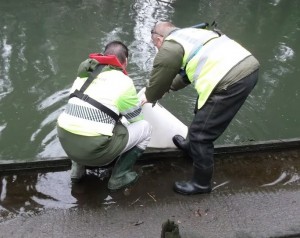 Just over one year on from the devastating pollution of the River Crane, the Environment Agency has begun a programme of fish restocking.
Just over one year on from the devastating pollution of the River Crane, the Environment Agency has begun a programme of fish restocking.
In October 2011, a tsunami of raw sewage was released into the river following a failure in part of Thames Water’s infrastructure, resulting in a major pollution incident which affected 7 miles of river.
The severity of the pollution incident and its impact on the river saw nearly all aquatic life eradicated, killing in excess of 10,000 fish and millions of invertebrates. The clean-up operation has taken many months and if not for the high spring and summer flows, the river would not yet be in a suitable position to receive new life.
However, in late December, 5,500 1-2 year-old fish were introduced including barbel, dace, roach and chub, all from the Environment Agency’s Calverton Fish Farm near Nottingham.
A Thames Anglers’ Conservancy spokesman said:
“While we welcome this early restocking of the river, we would like to see more mature fish going in as well. The EA provided fish from their Calverton Fish Farm but they are unlikely to reach sexual maturity for several years and therefore the population has little chance of naturally increasing. We are working from within the Crane Valley Partnership and along with Thames Water, looking at the possibility of other sources of fish, so varying the age range. Other species such as perch cannot be stocked by the EA so we will push for all other avenues to be considered.”
The lengthy criminal investigation into the pollution incident is still in progress.
Posted in News
Tagged Environment Agency, Pollution, River Crane, Sewage, TAC, Thames Water
Comments Off on New life for polluted River Crane
Proposed Barrage across the Severn Estuary ‘could be absolutely devastating’
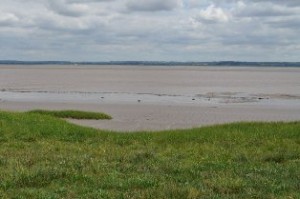 A Proposal to build a Barrage across the Severn Estuary 'could be absolutely devastating', MPs have heard. The Angling Trust, Wildfowl & Wetlands Trust (WWT) and RSPB told the House of Commons Energy & Climate Committee they all supported tidal energy development in the Severn, but that the current proposal lacks detail and claims that it would not unacceptably damage wildlife and large areas of habitat are "not realistic".
A Proposal to build a Barrage across the Severn Estuary 'could be absolutely devastating', MPs have heard. The Angling Trust, Wildfowl & Wetlands Trust (WWT) and RSPB told the House of Commons Energy & Climate Committee they all supported tidal energy development in the Severn, but that the current proposal lacks detail and claims that it would not unacceptably damage wildlife and large areas of habitat are "not realistic".
River Severn estuary – Nicholas Mutton
As well as doubting claims about the environmental impact of the barrage, all four organisations expressed support for future alternative smaller projects in the Severn Estuary to test and develop new tidal energy technology which Britain could export globally.
Angling Trust National Campaigns Coordinator Martin Salter told the Committee a full-width barrage across the estuary would mean fish dying due to sudden changes in water pressure and salinity, and through turbine strikes. He said: "Claims that these turbines are fish friendly are absolute guff. This is 24/7 fish mincing. Turbines kill fish above a tip speed of 6-7 metres per second. The Hafren proposal is for a tip speed of 9 metres per second. How on earth can they make press statements that these are "fish-friendly". They are simply not. "This drives a coach and horses through all environmental protections that governments have signed up to. The impact could be absolutely devastating on both the commercial fishery, on the recreational fishery and on highly protected habitat."
WWT Chief Executive Martin Spray told MPs: "This represents such a massive investment and such a massive change to the estuary that we do need more information. We have got to get a little more clever about how we address the environment. There is potential for energy generation but we have to come up with environmentally sustainable, acceptable and sensible solutions."
RSPB Head of Site Conservation Policy Kate Jennings said experiences elsewhere suggest smaller projects would be a better way to test new technologies rather than repeat experiences in the Netherlands: "The experience in the Eastern Scheldt estuary in the Netherlands where they built a storm surge barrier in the 1980s is the best comparator for the Severn Barrage. What they found is that 30 years after construction the estuary is still losing intertidal habitat. They think it will go on losing habitat for at least a century. "The official Government study into the Severn Barrage proposal in 2010 showed that there would be significant effects on the populations of 30 species of birds and that in addition to the Severn it would also have negative impact on at least five other internationally important wildlife sites nearby."
Kate also addressed claims that a barrage would reduce flood risk by protecting against storm surges, telling MPs a barrage could actually increase flood risk upstream: "There are other forms of flood risk. A significant one being fluvial (rivers) and managing that relies on the ability to get water out of the Severn. Holding it back behind a barrage would compromise that and tide-lock drainage. We don't have enough details of the proposals."
The Angling Trust, WWT, and RSPB have also agreed a joint position regarding the Severn Barrage with several other environmental organisations – WWF-UK, the Wildlife Trusts, Wye & Usk Foundation, Marine Conservation Society, Severn Rivers Trust, Salmon & Trout Association and Campaign to Protect Rural England.
The agreed position was sent in a letter to Hafren Power and Peter Hain who supports the barrage proposal. The position was summarised as: "We support the deployment of renewable energy as an essential element of the steps required to decarbonise the UK economy, and acknowledge the potential of the Severn Estuary for renewable energy generation. "However, we believe that renewable energy deployment can and should be delivered without unacceptable impacts on the environment. To date we have not been presented with sufficient detail on the current proposal, or any assessment of the impacts of that proposal, which would allow us to consider the extent to which its impacts would differ from those of the completely unacceptable high head Cardiff to Weston barrage (especially in the long term). That said, we remain deeply sceptical that a shore-to-shore barrage can be delivered without unacceptable impacts on the environment. "Given the likely scale of the impacts of such a development, and the associated environmental, social, technical, legal and investor challenges and risks, we believe that an approach which focuses on smaller scale deployment, sited and designed to maximise energy output whilst minimising environmental impact, is more likely to deliver an acceptable solution in a timescale compatible with the urgent need to address climate change and maintain electricity supply."
Read the full statement on the Angling Trust website
Posted in News
Tagged Angling Trust, Environment Agency, Hydropower, Martin Salter
Comments Off on Proposed Barrage across the Severn Estuary ‘could be absolutely devastating’
Suffolk firm fined £20,000 plus costs for oil pollution and fish kill
Suffolk malt producer, Pauls Malt Ltd, has been fined £20,000 and ordered to pay full costs for causing oil pollution to the River Lark. Bury St Edmunds Magistrates’ Court heard that gas fuel oil escaped from a tank at the premises on Eastern Way, Bury St Edmunds.
The oil entered the River Lark via a surface water outfall, polluting the river and killing dozens of fish. Mrs Corfield, prosecuting for the Environment Agency, explained that a secondary metal oil tank on site was surrounded by a brick bund.
A pipe passed through the bund wall and ended approximately one metre from a surface water drain. The joint between the bund wall and the pipe was not effectively sealed and oil had escaped and entered the drain which led to the River Lark. The court heard that the secondary tank was filled from two outdoor bulk tanks and filling was controlled solely by an automated float valve.
The incident was caused by the float valve malfunctioning causing oil to flow continuously to the secondary tank and discharge from the overflow pipe. Mrs Corfield said that the company did not have risk reduction measures in place to check and maintain the secondary tank, bund and float valve and they knew the float valve was not a fail safe system. Mrs Corfield told the court that the oil leak caused a serious environmental impact on the River Lark for at least 3.7kms downstream.
At least 47 fish were killed and over 100 fish were observed in distress. There was also an impact on air-breathing and surface-dwelling invertebrates and the pollution caused public concern affecting the amenity of the area through appearance and smell. In mitigation, Ms Kate Kelleher, barrister, said that the incident happened when engineers were on site testing the boilers in preparation for winter in the event of disruption to the gas supply.
The company spent £106,304 on the clean up and maintenance costs and has approved further works at a cost of £11,000 to prevent recurrence. After the hearing, Environment Agency officer Ross McIntyre said: “This pollution and these fish deaths could have been avoided if adequate preventative measures had been in place for the oil tank.”
Posted in News
Tagged Environment Agency, Fish KIll, Pollution, Sewage
Comments Off on Suffolk firm fined £20,000 plus costs for oil pollution and fish kill
December was the 7th consecutive month of above average rainfall
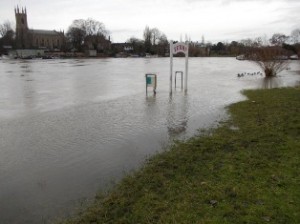 The Environment Agency water report for December shows it was the 7th consecutive month of above average rainfall for the South East Region. Flows and groundwater levels continued to respond to rainfall on already saturated catchments. Most of the key sites are now at notably high levels or higher for the time of year and sixty eight flood warnings were issued.
The Environment Agency water report for December shows it was the 7th consecutive month of above average rainfall for the South East Region. Flows and groundwater levels continued to respond to rainfall on already saturated catchments. Most of the key sites are now at notably high levels or higher for the time of year and sixty eight flood warnings were issued.
Rainfall
The trend of wet months has continued, with December being the 7 th consecutive month with above average rainfall. The Region received 178% of the long term average rainfall for December, with the south of the Region wetter than the north. Total rainfall from the 19 th to the end of the month comprised about 70% of the monthly totals. There was widespread rainfall across the Region on the 19 th of December, with totals in excess of 40mm being recorded at a number of sites extending from East Hampshire Chalk to East Sussex Chalk and about 25mm being recorded on the Chilterns and Lee Chalk. The drought from October 2010 was broken by widespread rainfall from April onwards, with the Region and many catchments to the south and west having the wettest 9 months on record with up to 186% of the long term average for the period. 2012 has been the second wettest year on record for South East Region, with 2000 being the wettest. Cotswolds West and Thame catchments both had the wettest year on record.
Soil Moisture Deficit
Recharge and Groundwater Levels The soil moisture deficits remained zero during December, resulting in the Region continuing to be particularly responsive to any rainfall. The high rainfall totals and the saturated conditions resulted in an estimated two and a half times the average recharge during December. Groundwater levels have continued to rise at all the key indicator sites in response to the heavy rainfall and higher than average recharge. Five sites in the Chalk to the south and Jackaments in the Cotswolds have exceptionally high levels and 4 sites have notably high levels. Houndean Bottom (East Sussex Chalk) and Chilgrove (West Sussex Chalk) had the highest levels on record for December. Jackaments (Cotswolds West) and Rockley (Berkshire Downs) recorded the second highest levels for December, after 2000.
River Flows
As would be expected with a saturated catchment, all the rivers responded to the rainfall, particularly after the 19 th of the month. Eleven of the indicator sites had exceptionally high flows for December and eight had notably high flows. The monthly average flows were the 2 nd highest on record for seven of the rivers after December 2000. The peak daily flow for the River Coln at Bibury on the 25 th December was the highest on record. The River Kennet at Theale and the River Ver at Colney Street had above normal flows during December.
Reservoir Storage/Water Resource Zone Stocks
Reservoir storage was above or close to average for the time of year, with many of the online reservoirs close to capacity. Farmoor is the exception to this as abstraction was restricted by the water company owing to issues with high sediment in the Thames.
Full report
Posted in News
Tagged Environment Agency, Flood, Thames
Comments Off on December was the 7th consecutive month of above average rainfall
Tideway Times – Winter 2012
Tideway Times is a quarterly newsletter featuring the latest news and events on the London Tideway Improvements, which includes the proposed Thames Tideway Tunnel, the Lee Tunnel and Sewage Works Upgrades.
http://www.thameswater.co.uk/tw/common/downloads/aboutus-projects-tidal-thames/tideway-times-winter-December-2012.pdf
Posted in News
Tagged Sewage, Super Sewer, Thames, Thames Water, Tideway Tunnel
Comments Off on Tideway Times – Winter 2012
Environment Agency criticised over Hydropower schemes
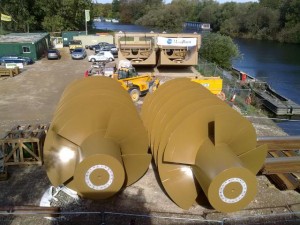 The Environment Agency has come in for severe criticism this week for failing to uphold its duties to ‘to maintain, improve and develop fisheries’ and to ‘consider and give due weight to fisheries’ when granting impoundment licences associated with hydropower schemes.
The Environment Agency has come in for severe criticism this week for failing to uphold its duties to ‘to maintain, improve and develop fisheries’ and to ‘consider and give due weight to fisheries’ when granting impoundment licences associated with hydropower schemes.
The Angling Trust and fisheries conservation charities have joined forces to write a strongly-worded letter to Paul Leinster, Chief Executive of the Environment Agency highlighting his organisation’s shambolic regulation of hydropower and demanding immediate action. The recent successful action by Fish Legal on behalf of the Pride of Derby Angling Club at Sawley weir to halt the damaging hydropower scheme on the river Trent was seriously hindered by the actions of the EA who granted an impoundment licence to the developers without any regard to the impact on the fishery.
The developers were granted a permit by the Agency which allowed them to kill up to 10 adult salmon and 100 coarse fish in a 24 hour period without fear of enforcement action. By granting this licence the Agency also gave a private company a statutory defence to any civil claims against it for damaging the fishery caused by changing water levels and flow rates.
The Angling Trust, supported by the Salmon & Trout Association and the Atlantic Salmon Trust have written to Paul Leinster to demand immediate action to protect rivers and fish stocks from hydropower developments. Representatives of these organisations will meet with Mr. Leinster in January to discuss these points and to highlight the concerns of anglers and fishery owners.
A report commissioned by an independent expert as long ago as August of 2009 said that the Good Practice Guidelines for hydropower developers were 'not fit for purpose'. The Environment Agency has still, more than three years later, failed to update these guidelines and will not do so for at least another year. The letter demands an acceleration of this process and a retraction of statements made by the EA’s Head of Climate Change who implied that this completely unacceptable delay might in some way have been caused by the angling and fisheries organisations themselves.
Angling Trust and Fish Legal Chief Executive Mark Lloyd said: “This minimal level of attention is utterly inadequate from a public body which has a statutory duty to maintain, improve and develop fisheries and the Judge’s decision that the fishing rights would be significantly harmed demonstrates the EA’s failure in this regard. What’s more, by granting the licence, the EA made it much harder for Fish Legal to fight its civil legal action to stop the Sawley development going ahead. We still won the case but no thanks to the Environment Agency whose handling of hydropower applications is nothing short of an ‘omnishambles’”
Letter to Paul Leinster, CEO of the Environment Agency
Posted in News
Tagged Angling Trust, EA, Environment Agency, Hydropower
Comments Off on Environment Agency criticised over Hydropower schemes
EA Briefing note on the River Crane Pollution
Environment Agency Update on River Crane pollution incident – December 2012
The River Crane is an important river for West London. Not only does it provide a valuable green corridor for wildlife, it also gives local people a rare opportunity to get close to nature within an urban environment. On the last weekend of October 2011, we were informed of a major pollution incident. A seven mile stretch of the River Crane and parts of the Duke of Northumberland’s River had been polluted with crude sewage.
The severity of this pollution incident and its impact upon the river only became apparent during the days that followed. Our officers worked with other organisations around the clock to minimise the environmental damage. The pollution had a devastating effect on wildlife and was responsible for killing thousands of fish. The clean-up that followed has taken many months, many people and a lot of hard work.
One year on
We remain committed to restoring the River Crane and Duke of Northumberland’s River. We are also committed to holding to account those responsible for the pollution. Our criminal investigation is progressing well and a number of our staff are involved in gathering evidence and assessing the incident’s severity. We are working hard to complete our investigation as soon as possible, however the case is very complex and involves a number of parties. We are unable to confirm if or who we will be prosecuting at this stage, as this may prejudice the case. In the meantime, we continue to assess the incident’s long-term impact on the ecology of the river.
We are working with members of The Crane Valley Partnership and other community groups to prioritise what work can be carried out to assist the recovery. Today there are early but encouraging signs of returning life. This has included natural recolonisation of shrimps, other invertebrates and fry (small fish) downstream of where the pollution entered the river.
Future restoration of the River Crane
Recently, we have carried out a number of surveys of the river. The data we have gathered will help shape the proposed actions in our restoration programme. We also hope that the programme will include ideas from local people and members of The Crane Valley Partnership. The Crane Valley Partnership includes expertise from organisations such as the London Wildlife Trust.
This partnership has a proven track record of delivering environmental projects that have improved the river over a number of years. We see the partnership taking on the crucial role of prioritising the work that will help bring about the recovery of the river. We have drafted a four year fish restocking strategy and are starting the first phase of restocking this December. We will be using fish from our Calverton Fish Farm, including 1,500 Chub, 1,500 Dace, 1,500 Roach and 1,000 Barbel (at a cost of around £5000). These fish will be released throughout the affected reaches of the river.
Small fish are stocked in larger numbers so the fish populations can shoal and spread out throughout the affected stretches. Over the years to come, a new fish population will eventually develop. The fish restocking strategy forms part of our vision for the river. We hope it evolves further as we continue to work in collaboration with the Crane Valley Partnership and local communities. The species we have selected to release are representative of those lost as a result of the incident. However, we do not have all the original species available at our fish farm. We have therefore selected those species that are available, were originally present in the river and are suitable for restocking. We will, however, check for other potential sources of fish. We have specifically chosen to release the fish in winter as the low temperatures and high levels of oxygen in the river make the process less stressful for the fish, increasing their chance of survival. In addition, there are lower numbers of naturally occurring parasites and pathogens, posing less of a threat to the fish as they adjust to their new environment.
What happens next?
Once we have completed our investigation, we will present the results to our legal department. They will then decide what enforcement action should be taken. We want to ensure the River Crane is restored, as far as possible, to the condition it was in before the incident, and that polluters are held accountable where an offence has been committed. By continuing to work closely with The Crane Valley Partnership and other local groups, we will make the best use of available resources and will get the best result for the environment. It is our continued aspiration that in further years the condition of the river is better than it was before the pollution incident.
Posted in News
Tagged EA, Environment Agency, Pollution, River Crane, Sewage
Comments Off on EA Briefing note on the River Crane Pollution
The ZSL’s ‘Citizen Science’ European Eel monitoring Report 2012
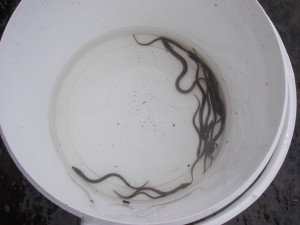 The Zoological Society of London’s Citizen Science, European Eel monitoring project Report for 2012
The Zoological Society of London’s Citizen Science, European Eel monitoring project Report for 2012
Executive Summary
Over the past 30 years it has become apparent that European Eel (Anguilla anguilla) recruitment into European rivers has declined rapidly and despite the increased awareness of the situation, and the development of action plans and legislation at local, national and European levels, numbers do not appear to be recovering on a large scale.
In 2008 the International Union for Conservation of Nature classified the species as Critically Endangered. In 2005 ZSL set up its European eel monitoring programme to assess the presence of migrating juvenile eels, identify restrictions to their movements and gather long term data on trends in eel recruitment in the Thames catchment. In 2011, in order to expand this monitoring programme, ZSL began to engage the general public and enlist the help of volunteers.
ZSL now works with 10 partnership organisations and, to date, has trained 167 volunteers to become Citizen Scientists involved in the eel monitoring project. During the upstream juvenile eel migration period, April-October, Citizen Scientists check eel traps twice a week at eight monitoring sites in the Thames catchment. The number and size of all trapped eels are recorded and data are uploaded on to the ZSL database.
At the end of the monitoring season these data are feed into the Environment Agency’s Eel Management Plan for the Thames River Basin District. The programme fulfils an important research and educational role in the drive to improve rivers for eels. In the future, ZSL will work with its Citizen Science partners to emphasise the part they can play in helping this iconic species.
A particular problem in the River Thames catchment is the number of barriers, such as weirs, that prevent or hinder upstream migration and reduce the amount of available habitat to eels. We are working with our partners to identify the most significant barriers and build eel passes over a number of them to facilitate eel migration. Together, we can build capacity in the sector as a whole to tackle issues threatening the conservation of the European eel.
The Citizen Science European eel monitoring project will continue for the 2013 upstream juvenile eel migration period, however, In order to maintain conservation effort and build upon the valuable foundation that has been developed, ZSL will need to raise funds for the programme from spring 2014.
Full report can be found Here
Chalkstream Charter to follow summit in Hampshire
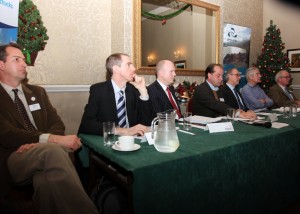 Over 100 of the top figures in English fly-fishing packed into a special summit called to discuss the plight of our chalkstreams at the Grosvenor Hotel in Stockbridge this week.
Over 100 of the top figures in English fly-fishing packed into a special summit called to discuss the plight of our chalkstreams at the Grosvenor Hotel in Stockbridge this week.
Of these unique rivers, 85% are situated in England and most of these are in the South with the most famous being the Test, Itchen and Avon in Hampshire – rivers that were once considered to offer the finest trout fishing in the world. Chalkstreams are internationally significant habitats which are under extreme pressure from diffuse pollution, over abstraction and habitat damage. Many came close to an environmental disaster during last year's drought and were only saved by exceptional rainfall during the summer of 2012.
Speakers at the summit, including the Angling Trust's Martin Salter and leading conservationist Tony Juniper, argued that special protection for chalkstreams should be enshrined within the current Water Bill. They called for radical reform of water resources and land use policy to enable all rivers to return to good ecological status free from damaging environmental impacts. It was agreed that a special Chalkstream Charter would be drawn up as a matter of urgency and presented to Environment Minister Richard Benyon early in the New Year.
The summit was addressed by Lords Environment Minister Rupert de Mauley who stood in for Richard Benyon. The day began with the showing of two films on the plight of chalkstreams made by award-winning film maker Hugh Miles. It concluded with a panel discussion with top officials from Defra and the Environment Agency along with representatives of the Angling Trust and the Salmon & Trout Association (S&TA). Participants included broadcaster and writer Charles Rangeley-Wilson, top flyfisher Charles Jardine, local river trust and wildlife groups, a number of MPs and many prominent fishery owners on the Test, Itchen, Kennet, Avon and other chalkstreams.
The meeting was chaired by George Hollingbery MP, who is Chairman of the All Party Parliamentary Angling Group.
Paul Knight, Chief Executive of the S&TA, said, "The Defra civil servants praised the passion of the hundred plus people in the room. What they must realise is the huge knowledge, experience and scientific evidence that the assembled company represented which, in addition to the passion, means we are determined to achieve the protection for our chalkstreams that these iconic rivers deserve. The Government has two choices; be proactive and provide the legal structure and new resources required for the job now, or risk infraction from the European Commission if chalkstream degradation continues."
Mark Lloyd, Chief Executive of the Angling Trust and Fish Legal said: "The fact that this meeting was standing-room only indicates how strongly the angling community feels about the disgraceful management of our chalk streams over the past few decades. We are all fed up with sitting through consultation events to draw up plans which never get implemented. I hope that the senior Defra officials who attended will have taken away a clear message that the time for fine words has long since passed and that millions of anglers expect to see real action that improves the water quality and quantity of these precious, unique rivers and restores the habitat which is vital for healthy, wild fisheries. Our Chalkstream Charter will set out in detail what needs to be done."
Posted in News
Tagged Angling Trust, Chalkstream, Martin Salter
Comments Off on Chalkstream Charter to follow summit in Hampshire


